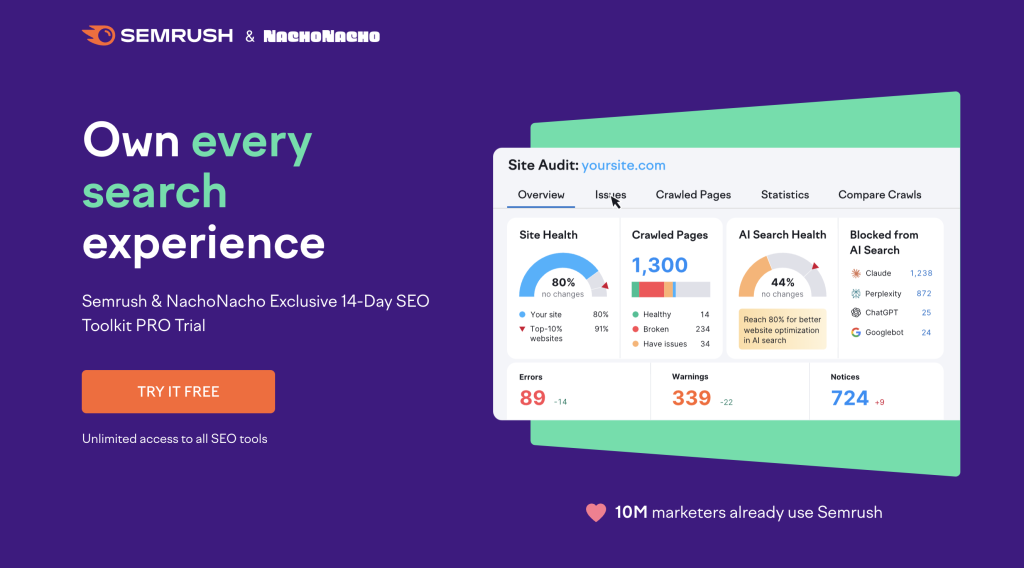SEO is Dying: Guide to Future-Proof SEO/GEO
In the evolution of SEO, businesses are now focused on optimizing content to be easily understood, cited, and excerpted by large language models (LLMs) and generative AI features within major platforms (like Google’s AI Overviews, Perplexity, or Copilot). The goal shifts from merely ranking #1 to becoming the trusted source that AI chooses to reference.
Based on current research and industry best practices, here is a comprehensive guide to implementing a successful AI SEO strategy, also referred to as Generative Engine Optimization (GEO).
Table of contents
Why AI Visibility Matters
If AI platforms rarely send traffic today, why worry about them? There are three reasons:
- C‑suite pressure. Nine in ten decision‑makers now ask how their brands appear in AI search. Reporting on keyword rankings alone is no longer sufficient.
- New sources of influence. Generative search surfaces expose your brand to potential customers who may never click through. According to Semrush’s research, AI search visitors convert 4.4× better than traditional organic visitors. When an LLM mentions your product, it often appears to a user who is closer to making a decision.
- Inevitable change. Google, Microsoft and numerous startups are racing to embed AI into search. The CEO of 10 Fold Communications notes that AI‑first optimisation (sometimes called generative engine optimisation, or GEO) has become the top success metric for 35% of B2B marketers, and 37% of marketers are investing in AI‑search visibility.
In other words, ignoring AI search now could leave you invisible tomorrow, but focusing on AI at the expense of proven SEO fundamentals risks losing today’s revenue.
The solution is a dual optimisation strategy: continue optimizing for traditional SERPs while building AI‑ready content and measuring your brand’s presence across LLMs.
Measure your AI visibility
Before you begin making changes to your website and writing content, it’s helpful to look at how good your current AI visibility is. There are 2 ways that you can start measuring your visibility.
Run a Manual AI Visibility Test
- Open ChatGPT, Gemini (Google’s AI Mode), and Perplexity.
- Ask the questions your audience would ask, such as “What are the top AI SEO tools?” or “Best keyword research platforms for startups.”
- Examine the answers and note whether your brand is mentioned, cited, or linked.
- Repeat the test monthly to spot trends.
Use Semrush’s AI Visibility Toolkit

Similar to looking at your website authority, Semrush’s AI Visibility Toolkit shows how often your brand is cited in AI answers and provides a visibility score (1–100).
You can try this feature with a 7-day free trial of Semrush ONE, the all-in-one platform that combines industry-leading SEO tools with advanced AI search visibility capabilities.
Other things you measure with Semrush ONE AI visibility tools are:
| Semrush AI Visibility feature | What it measures |
| Visibility overview | Calculates your domain’s AI visibility score, showing how often you appear in AI answers and suggesting opportunities to gain citations. |
| Competitor research | Reveals which prompts competitors appear for and which sources cite them. |
| Prompt research | Discovers real questions users ask in AI chats, so you can target high‑intent queries. |
| Brand performance & sentiment | Monitors share of voice and how AI platforms describe your brand compared to rivals. |
| Narrative drivers & perception | Shows the themes influencing your brand’s portrayal in AI answers. |
| Prompt tracking | Tracks your priority prompts over time to measure gains or losses in visibility. |
| AI‑powered recommendations | Suggests actions to improve your visibility based on data across platforms. |
With these insights, you can quantify your AI presence, benchmark against competitors, and integrate those findings into your broader SEO strategy.
👉 Try Semrush ONE free for 7 days and get the most comprehensive visibility database for both SEO and AI discovery engines like ChatGPT and Perplexity.
Now that you know how much work your website needs, let’s continue to the main things you can do to improve this score.
The Core Shift: From Clicks to Citations
The most fundamental change in the age of generative AI is the primary measure of success. In traditional SEO, the goal was to get a user to click on your link and land on your page. With AI Overviews and answer engines, the AI often provides a direct, synthesized answer, resulting in a zero-click search.
The new goal is for the AI to cite your content as the authoritative source for its answer.
The Generative Engine Optimization Mindset
| Traditional SEO Goal | Generative Engine Optimization (GEO) Goal |
| Rank at position #1 for a keyword. | Be cited as a source within the AI-generated answer. |
| Optimize for a single, high-volume keyword. | Optimize for conversational, long-tail, and multi-step queries. |
| Structure for human readability (first). | Structure for machine comprehensibility (first) and human value (second). |
| Authority is measured by E-E-A-T (Experience, Expertise, Authoritativeness, Trustworthiness) and specific fact citations. | Authority measured by E-E-A-T (Experience, Expertise, Authoritativeness, Trustworthiness) and specific fact citations. |
Content Optimization for AI Comprehension
AI models need content that is structured, unambiguous, and easily extractable. Your content must be designed to be quotable.
Prioritize Snippability and Direct Answers
The most critical change is how you structure the beginning of your content sections.
Lead with the answer. Begin sections with a clear, direct statement that answers the question posed by the heading. For example, if the section is “What is canonicalization?”, open with “Canonicalization is the process of selecting the preferred version of a set of duplicate URLs to avoid indexation issues.” This helps LLMs lift the answer without reading the entire page.
Use modular formatting. Break complex information into bulleted or numbered lists, tables, and Q&A sections. This structure makes it easier for AI to parse discrete facts. Semrush’s Content Outline Builder can help you design outlines with hierarchical headings and key points.
Create comparison tables. When comparing tools, plans, or processes, summarise differences in a table with short phrases. Avoid long sentences; LLMs parse tables more reliably.
Embrace Semantic and Conversational Language
AI search queries are more conversational than traditional search queries. They often include long‑tail or multi‑step questions like “How can AI tools enhance my local SEO strategy?” or “What is the best way to optimise for AI search in e‑commerce?” To align with these patterns:
- Target Conversational Queries: People search differently in an AI chat than they do in a traditional search bar. Focus on long-tail, question-based keywords that include “how,” “why,” “what is,” and “best way to.”
- Write for Intent: Ensure your content fully addresses the intent behind the user’s query. A user searching for “best running shoes” is in the evaluation/decision stage, so your content must provide comparisons, reviews, and a clear recommendation, not just a definition of what a running shoe is.
- Semantic Depth (Topic Clusters): Create comprehensive content that covers an entire topic area, not just a single keyword. Use a hub-and-spoke model with one authoritative “pillar” page linking out to several detailed sub-topic pages. This helps AI understand you have complete topical authority.
Establishing and Signaling Authority (E-E-A-T)
In an environment where AI can hallucinate or synthesize incorrect information, the quality, credibility, and trustworthiness of your source content are more important than ever. Google explicitly uses the E-E-A-T framework: Experience, Expertise, Authoritativeness, and Trustworthiness.
Show, Don’t Just Tell, Your Experience and Expertise
First-Hand Experience: For content where experience matters (e.g., reviews, how-tos, technical guides), integrate proof of your direct experience. Include proprietary photos, original data, detailed case studies, video demonstrations, and step-by-step processes you personally conducted.
Author Credentials: Make it clear who created the content and why they are qualified. Ensure author bios are complete, include relevant certifications, degrees, and professional experience, and are linked prominently to the article. For health, finance, or highly technical topics, include a Reviewed By line with a qualified expert’s credentials.
Build Trust with Citations and Evidence
There are 3 main ways you can achieve this:
- Cite Primary Sources: Every statistic, fact, or major claim should be backed up with a link to the original, authoritative source (e.g., scientific study, government report, major news outlet). AI models look for “atomic facts with clean attribution.”
- Original Data: The single best way to become a definitive source is to publish original, first-party data, surveys, or research. This is content the AI must cite you for because it cannot find it elsewhere.
- External Validation: AI models are influenced by what third-party authorities say about you. Seek to be mentioned (not just linked to) in authoritative “best of” lists, industry reports, and trade publications. Encourage detailed customer reviews on trusted third-party platforms.
Technical SEO for Machine Readability
Technical SEO ensures that AI models can easily crawl, index, and understand the structure and context of your site.
Structured Data (Schema Markup)
Schema markup provides explicit context to your content, helping AI understand the type of content it is viewing.
Implement High-Value Schema:
- FAQPage: For question-and-answer sections.
- HowTo: For step-by-step instructional content.
- Product and Review: For e-commerce and product comparison content.
- Article and Organization: To establish your content and brand authority.
Crawlability and Internal Structure
Just as with traditional SEO, 2 often overlooked aspects of visibility are internal linking and site speed.
Use internal links to create a clear web of interconnected topics that reinforce your topical authority. The anchor text should be descriptive, helping both users and AI understand the relationship between pages.
Additionally, fast-loading, technically clean websites are easier for all crawlers to process. Follow Core Web Vitals best practices. AI won’t cite content it can’t quickly and reliably access.
Continuous Improvement
- Content Audits for Freshness: AI prioritizes fresh, relevant information. Institute a regular audit cycle (e.g., every 3-6 months) to update stats, facts, product details, and expert commentary in your most critical pages. Don’t just change the date; add substantive new value.
- Embrace the Iterative Model: The AI search environment is volatile. Test new content formats (short paragraphs, answer boxes, data visualizations) and quickly adapt based on which structures lead to citations.
By focusing on exceptional E-E-A-T, meticulous content structure, semantic depth, and clear, quotable answers, you can effectively implement AI SEO and position your brand as the authoritative source in the next generation of search.
Should you focus on SEO or GEO?
Is your target audience using AI to discover solutions like yours?
Google and traditional search engines continue to be the main discovery channel for many areas, with Google processing around 14 billion searches per day compared to ChatGPT, which processes an estimated 37.5 million to around 66 million per day.
However, Google is doing a large push for integrating AI search into its systems. Now there are AI overviews, AI mode, and Gemini with the purpose of accommodating this new way of search that more and more users expect.
That means AI search and traditional SEO are merging fast. In addition, large players have been dominating SEO results for a long time, making it difficult for smaller businesses to succeed.
But with GEO, you can compete with these larger companies and access a great opportunity to acquire customers, if that’s a channel your target audience uses to discover solutions like yours.
Future-Proof your SEO and GEO
To stay visible across all search platforms, check out Semrush ONE.
Start your free 7-day trial today and see how your brand appears across Google, ChatGPT, Gemini, and Perplexity. Then, use all of its tools to improve your visibility and start increasing your traffic from these platforms.

Written by Andres Muñoz
If you would like to receive the latest deals added to NachoNacho, make sure you sign up for our newsletter below. We’re adding amazing software discounts you can’t miss!
Sign up for our newsletter






